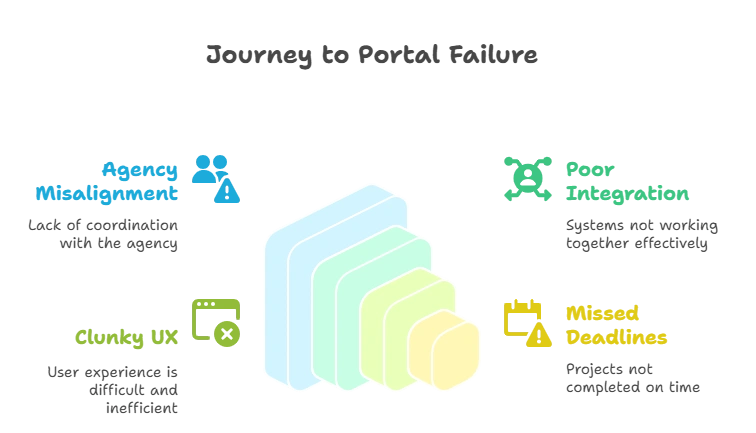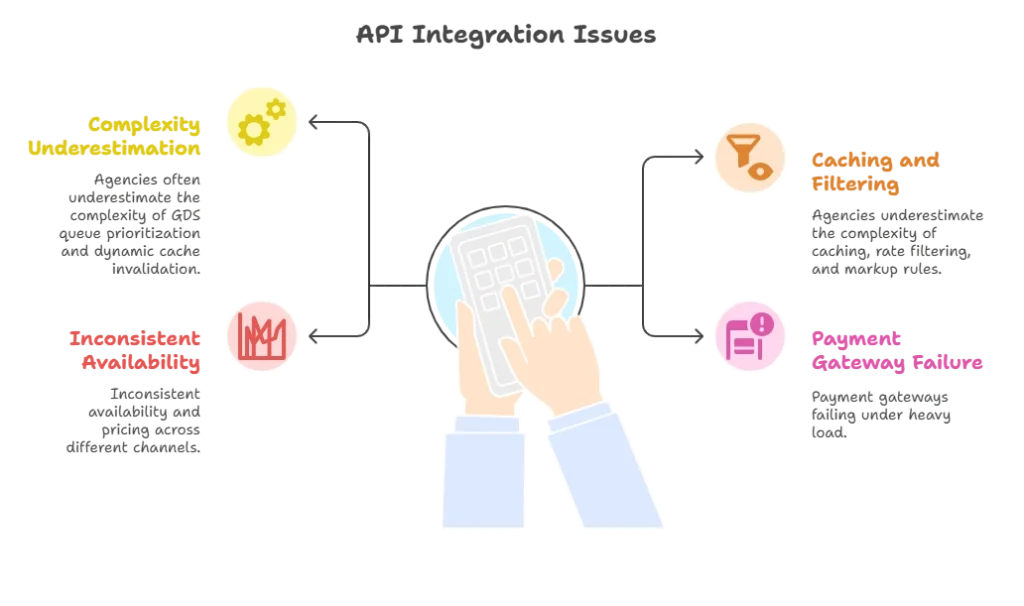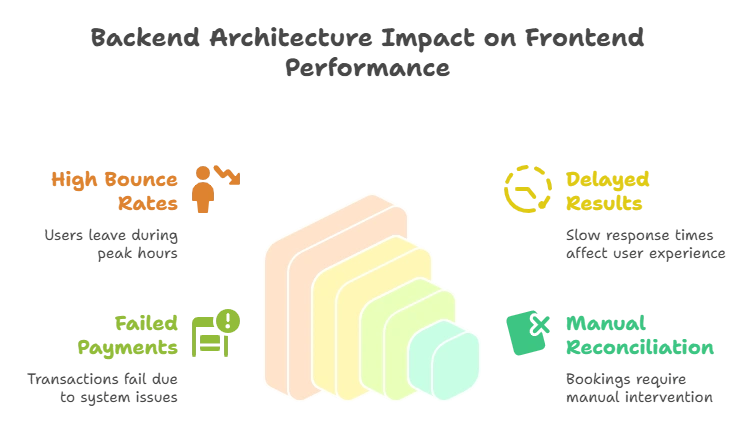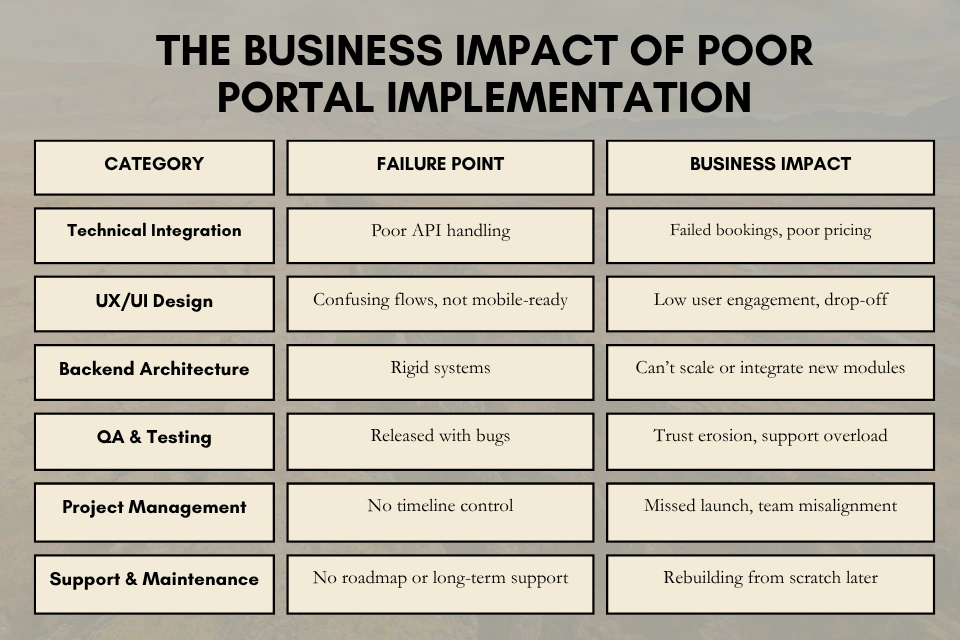Table of contents
The 47-Point Travel Portal Implementation Scorecard: Why 94% of Agencies Fail—and What Successful Businesses Do Differently
In the competitive world of travel, your portal is more than just a website—it’s the engine behind your entire customer experience. Whether you’re a B2B wholesaler, OTA, travel startup, or consolidator, a well-executed travel portal can unlock explosive growth.
But here’s the harsh reality:
Most travel portal projects fail—despite clear goals, a solid budget, and internal team support. (Based on our analysis of 150+ stalled/failed projects and industry benchmarks from Gartner/Phocuswright, we estimate this failure rate exceeds 94%)
Why?
Because the agency side of the equation—your chosen development partner—is often where things quietly fall apart.
As a company that has rescued dozens of broken travel portal implementations, we seen these patterns again and again. That’s why we’ve created the 47-point Travel Portal Implementation Scorecard—to help decision-makers identify where things go wrong, and more importantly, how to prevent costly failure.
Why Most Travel Portal Projects Never Launch (or Launch Poorly)

Even with well-documented business requirements, sufficient resources, and clear deadlines, portals frequently hit the wall during execution.
Here’s a breakdown of the most common agency-side failures we’ve seen—and how they directly impact your business.
1. Lack of Domain-Specific Technical Expertise
- Misunderstood APIs lead to non-functional modules.
- Inaccurate OTA syncing causes customer complaints.
- Poor data normalization results in search failures or pricing errors.
- Has your agency previously worked with complex travel APIs?
- Do they understand supplier-side rate structures and cancellations?
2. Weak Discovery and Planning Phase
Phase 3 is crucial—and often skipped or rushed.
This phase includes mapping user journeys, identifying edge cases, integrating commercial logic, and defining technical workflows before a single line of code is written.
What happens without it?
- Rework loops due to missing or misunderstood requirements
- Misaligned business logic (e.g., incorrect cancellation flows or offline booking support)
- Fragmented UX—confusing layouts, missed CTAs, abandoned bookings
How Nest Software Fixes This
Our 3-week Discovery Sprint maps 100% of edge cases and commercial logic upfront—saving clients 4 months of rework later.
3. Poor API Integration Execution

Integration with GDSs, hotel and flight consolidators, car rentals, payment gateways, or insurance APIs isn’t just plug-and-play.
Common Issues:
Agencies underestimate the complexity of GDS queue prioritization, dynamic cache invalidation for live inventory, and handling partial hotel room type mapping from consolidators.
- Agencies underestimate the complexity of caching, rate filtering, and markup rules
- Inconsistent availability/pricing across channels
- Payment gateways failing under load
Fix:
Insist on real-time testing, sandbox staging, and demonstrated success in dynamic, inventory-heavy environments.
4. Fragmented User Experience and Booking Flows
Many portals look fine on the surface but fail when it comes to seamless, intuitive user journeys.
What’s often wrong?
- Excessive form fields
- Confusing flow between search → select → payment
- No saved searches, recent bookings, or personalization
- Incomplete mobile optimization
Nest Software Philosophy:
Our UX team builds not just beautiful interfaces but frictionless travel experiences—especially for price-sensitive, time-pressed users.
5. Lack of Flexibility or Over-Templated Solutions
Beware the “white-label trap.”
Symptoms:
- Agency offers a templated portal that’s rigid
- Every customization costs extra or isn’t technically possible
- Can’t scale for B2B/B2C hybrid models later
Outcome:
You outgrow your system within 6 months—or worse, never fully launch due to functional limitations.
6. Weak Backend Architecture

If the backend can’t handle frequent price syncs, multi-supplier logic, or high search traffic, your frontend will eventually break.
Warning Signs:
- High bounce rates during peak hours
- Delayed results or failed payments
- Manual reconciliation of bookings
Nest Software Difference:
We architect systems with fault tolerance, speed, and scale in mind—using modular services and proven tech stacks.
7. Inadequate QA and Pre-Launch Testing
Rushing to launch without simulating real-world load, user behaviors, or edge cases? That’s a recipe for public failure.
You risk:
- Payment failures
- API mismatches
- Misleading filters or broken UI elements
What You Need:
Automated testing, regression scripts, sandbox mock data runs, and staged rollouts.
8. Poor Project Management and Communication
Many agencies fail not in code, but in coordination.
Key issues:
- No clear sprints, updates, or changelogs
- Ambiguous deliverables
- No direct line between client and technical lead
Fix:
Work with teams that offer transparent project dashboards, shared documentation, and weekly walkthroughs.
9. No Post-Launch Support or Scaling Strategy
“Once it’s live, we’re done.” ← If you hear this, run.
Support isn’t a bonus—it’s core infrastructure.
Common Failures Post-Launch:
- Bugs go unresolved for weeks
- Scaling (new markets, partners, or languages) becomes a new project altogether
- No system to measure or improve KPIs like conversion rate, session time, etc.
At our Travel Portal Development Company India, we offer guaranteed post-launch support with service-level agreements (SLAs), version upgrades, and performance optimizations as part of our roadmap.
10. Security, Compliance & Trust Blind Spots
Without secure authentication, encrypted payment processing, and compliance with GDPR or PCI-DSS, your business is exposed.
What goes wrong:
- Data breaches
- Payment failures
- Legal penalties in cross-border regions
What’s Required:
- SSL, OAuth, role-based access
- Encrypted token storage
- Regular security audits and penetration testing

How to Choose the Right Development Partner
If you’ve made it this far, you already understand one thing clearly:
The right development partner is the difference between a powerful travel platform and a failed experiment.
Here’s what to demand from your tech team (in-house or agency):
- Real travel domain experience (GDS, consolidators, hybrid models)
- Process-driven project planning (functional specs, timeline, roles)
- Thorough QA and UAT before go-live
- Transparent reporting and sprint-level communication
- Post-launch SLAs and proactive monitoring
- UX strategy with personalization, optimization, and modern tech
What Makes Nest Software Travel Portal’s Different?
We’ve quietly become the go-to travel portal partner for agencies and OTAs in India, the Middle East, and emerging markets—not because we promise quick solutions, but because we deliver sustainable ones.
For example, we recently helped a Dubai-based OTA recover a 6-month stalled project, enabling them to launch with 99.8% payment success rates and handle peak loads of 500+ concurrent searches.
- We’ve integrated with every major travel API—Amadeus API, Mystifly, Sabre API, Travel Boutique, TBO API Integration
- We build modular, scalable platforms for both B2B and B2C models
- We involve stakeholders at every phase—design to post-launch
- We speak the language of both travel agents and CTOs
- And we stay invested in your growth—way past the delivery milestone
Final Thought: It’s Not Just About Code
A travel portal is not just a development project.
It’s a business engine.
It must be engineered with the same precision you’d expect from your most critical asset.
If you’re planning your next portal—or stuck in one that’s dragging—you don’t need another vendor.
You need a true technology partner that not only understand requirement but also helps you translate your vision into a platform that performs, scales, and converts.
Let’s build something that doesn’t just launch.
Let’s build something that leads.

